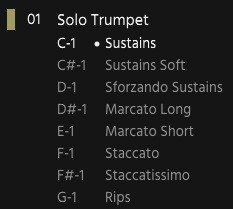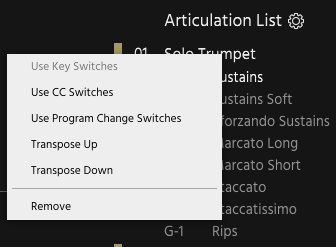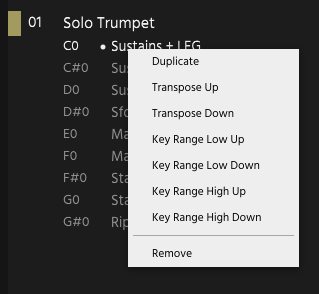Loaded Articulations
The Loaded Articulations area is displayed at the right of the Library View and Performance View and shows all currently loaded instruments and articulations.
It lets you load these, adjust their order and setup and change properties via the Articulation Options, which are displayed at its bottom.
Loading Instruments and Articulations
When you load SINEplayer; the Loaded Articulations area is empty. You can load instruments and articulations from the Library View, either by double-clicking an instrument/articulation or by dragging and dropping it into the Loaded Articulations area.
A loading bar will show the progress and instruments/articulations will light up once they are ready to use. SINEplayer will let you play partially loaded articulations, but we recommend waiting with playing until the instrument is fully loaded.
A loading bar will show the progress and instruments/articulations will light up once they are ready to use. SINEplayer will let you play partially loaded articulations, but we recommend waiting with playing until the instrument is fully loaded.
Loading something by double-clicking always adds it as a new "instrument" in the Loaded Articulations. An "instrument" is mapped to a unique MIDI Channel, which you can change by clicking on the channel number to the left of the name, and contains a number of articulations that can be switched between with the mouse, by Key Switches, MIDI CC values, or Program Changes. See "Instrument/Articulation Mapping Schemes" later in this article.

Instruments and articulations can be re-ordered by drag and drop and you can insert new articulations or duplicated ones anywhere. Key Switches/Program Changes/MIDI CC Values are assigned automatically and will adapt when you add or remove articulations.
Similarly, when you change MIDI channels, the Loaded Articulations area will reorder.
Active Articulation(s) and Editable Articulation
At any given moment, only one articulation from each instrument is the active one (unless you are using PolyMode). You can recognize the active articulation by its brighter color in the Articulation List.
Every articulation has a number of options which you can change in the Articulation Options panel at the bottom right. Only one articulation across all loaded instruments can be edited at a time. You can recognize the editable articulation by a little dot to the left of its name. Click an articulation with the mouse to edit its Articulation Options. Note that this selection does not follow Key Switches or other selection methods by design – only the articulation with the dot is influenced by the Articulation Options.

Instrument/Articulation Mapping Schemes
Within SINEplayer, an "instrument" is a collection of one or more articulations from the same physical instrument (e.g. an "instrument", as downloaded from the OT Store) that is addressed on one MIDI Channel. You can have multiple "instruments" on the same MIDI Channel, but they are still treated separately in terms of their options and mapping.
Each instrument can only hold articulations from that same physical instrument in it. It is not possible to load articulations from different instruments in the same place in the Articulation List. You can, however, assign multiple instruments to the same MIDI channel.
Within such an "instrument", there are four possible mapping schemes with which articulations within can be addressed. Multiple instruments can use different control schemes. You can, for example, have one instrument controlled by Key Switches, while another reacts to MIDI CC values.
1) Key Switches
In this mode, a key on your MIDI keyboard will select each articulation. Key Switches are assigned starting at the KS Area Start High or Low Instrument settings specified in the Options View. They are always consecutive and the starting point will be above or below the playable range. You can manually move the starting point for a particular instrument in the Virtual Keyboard in the Performance View. Playing a Kay Switch will influence all instruments that are set to react on the MIDI Channel the Key Switch is sent on. The keyswitches are assigned automatically when this control scheme is used, but you can set individual keyswitches simply by clicking on them and choosing an unused keyswitch.
2) CC Switches
In this mode, values of the Articulation Switch CC, which can be defined in the Options View under the Controller Map, will switch between articulations. The value range of that MIDI CC will be divided by the number of articulations in the instrument. Sending this MIDI CC will influence all instruments that are set to react on the MIDI Channel the CC is sent on. The CC values are assigned automatically with equal spacing when this control scheme is used, but you can set individual values simply by clicking on them and choosing an unused value.
3) Program Change Switches
In this mode, Program Change numbers will select the articulations. Sending a Program Change will influence all instruments that are set to react on the MIDI Channel the Program Change is sent on.
4) With MIDI Channels (only globally for the whole Articulation List)
In this mode, each articulation will be assigned its own MIDI Channel, essentially becoming its own instrument. This mode can only be automatically mapped for the whole Articulation List.
Global Remap Options
Clicking on the gear wheel next to the Articulation List label opens the Global Remap Options. Here you can remap the whole Articulation List in one go to use Key Switches (the default), individual MIDI Channels per Articulation, CC Values (per Instrument, using the Articulation Switch CC defined in the Options View) or Program Changes (per Instrument).

Lastly, in this menu you can also clear the Articulation List.
Instrument Context Menu
If you right-click an Instrument, the Instrument Context Menu opens, where you can remap this instrument to control articulations by Key Switches (default), MIDI CC Values or Program Changes. You can also transpose the whole instrument up or down and delete it from the Articulation List. All these changes are only made to the selected instrument, not to other instruments currently in the Articulation List.

Articulation Context Menu
If you right-click on an Articulation, the Articulation Context Menu provides options to duplicate it (for example if you want different legato settings for the same base articulation), adjust its Key Range, and remove it from the Articulation List.

